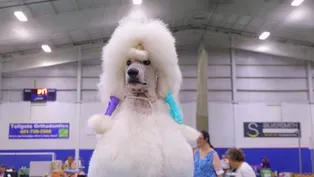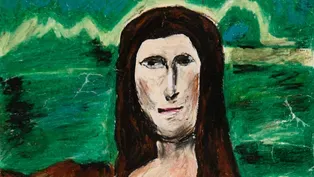
Consider the Taxidermist
Clip: Season 2 Episode 4 | 4m 43sVideo has Closed Captions
Taxidermist, artist, educator, and social media star: Meet Mickey Alice Kwapis.
Mickey Alice Kwapis is a specimen artist and preservation educator who regularly teaches at the Harvard Museum of Natural History. We sat in on some of her classes, and caught up with Mickey about the origin of her passion for taxidermy and the generations of women taxidermists who came before her.
Problems with Closed Captions? Closed Captioning Feedback
Problems with Closed Captions? Closed Captioning Feedback
Art Inc. is a local public television program presented by Rhode Island PBS

Consider the Taxidermist
Clip: Season 2 Episode 4 | 4m 43sVideo has Closed Captions
Mickey Alice Kwapis is a specimen artist and preservation educator who regularly teaches at the Harvard Museum of Natural History. We sat in on some of her classes, and caught up with Mickey about the origin of her passion for taxidermy and the generations of women taxidermists who came before her.
Problems with Closed Captions? Closed Captioning Feedback
How to Watch Art Inc.
Art Inc. is available to stream on pbs.org and the free PBS App, available on iPhone, Apple TV, Android TV, Android smartphones, Amazon Fire TV, Amazon Fire Tablet, Roku, Samsung Smart TV, and Vizio.
Providing Support for PBS.org
Learn Moreabout PBS online sponsorship(dramatic piano music) - If you saw me at the grocery store, you wouldn't think, "Oh, that girl skins animals for a living."
Hi, I'm Mickey.
If I had to take all the things that I love to do, and summarize them into one job title, I would call myself a "Specimen Artist".
I have a box of squirrels, I have a box of rats, I have a fox, some baby beavers, minks, lizards, pheasant chicks, ducklings, geese.
I have a big, big snake.
Four baby emus, a sparrow, a starling, a bunch of pigeons.
Thank you all so much for signing up for my class.
My name's Mickey.
I'm an art...
They say that art imitates life, but we also have life that has turned into death, that we then can turn into art.
Let's preserve a scorpion together.
Come take a specimen preservation class with me.
A private class on beetle specimen spreading.
If you think about it, taxidermy is a sculpture made from a real animal.
I try to keep a natural flow or shape, and then I try to just put the...
The specimens that we're collecting today contain basically a snapshot of what our world looks like at this moment in time.
- Okay, Hannah, show us your beetles.
- Let's get into it.
So just be gentle with your specimen.
You aren't gonna kill it, 'cause it's already dead.
But if you hear the cracking noise, and you're like... (Mickey gasps) It's fine, it's fine, it's normal.
It's been very, very cool, just to go from skinning a squirrel under lamplight at my friend's kitchen table, to now, 11 years later, teaching here at the Harvard Museum of Natural History.
(lighthearted mellow music) I did a Caucasus beetle class, where they got to lift up the elytra, and then spread the wings out.
Has everyone done their little beetle dance?
The front legs point forward, so they go like this, and the back two sets of legs point down, so they go like that.
And then we end of the day with a rat embalming class, so each student got to leave with a finished embalmed rat.
(student chuckles) I think that there are definitely stereotypes in the taxidermy industry today.
It's seen as primarily white male dominated.
A lot of people don't know this, but that work is directly a reflection of a woman who is widely considered to be the first female taxidermist.
Martha Maxwell exhibited her work at an expo in Philadelphia, where she built a full mountain inside of one of those fair buildings, and she filled it with her taxidermy animals that she had hunted and prepared herself.
And my favorite thing about her is that, she made a little plaque that said "Woman's work."
And she stuck it to the front of her exhibition.
So it's very cool to see how these patterns of taxidermy have held up over time.
(lighthearted piano music) My great-grandma, Mickey, who I'm obviously named after, was like the biggest champion of my work.
And she had these framed butterflies on the wall of the guest room when I was a kid.
And over the years, a couple of the butterflies came detached from the back glass, and they fell down.
And so she asked me, "Can you fix this?"
And I didn't even know this, but her aunt was the one who had made the frame, spread the butterflies, framed the butterflies.
So this had to have been back in the 1910s, 20s, 30s.
(soft piano music) So she actually got to come to one of my classes, and we spread butterflies together that matched the same color tones.
And then once they were dry, I snuck those butterflies into her frame, and I returned it to her.
So it was cool the last couple years of her life, every time I visited, I got to see butterflies that we spread together.
(soft piano music continues) What I'm doing right now is beyond my wildest dreams.
Taxidermy and specimen preservation are in my blood, whether I realized it when I started doing this or not.
(soft piano music continues) (mellow surf rock music)
Video has Closed Captions
Clip: S2 Ep4 | 4m 13s | Linda Seabury gives us her take on participating in AKC Confirmation shows. (4m 13s)
Video has Closed Captions
Clip: S2 Ep4 | 6m 47s | What is bad art? The Museum of Bad Art displays, and challenges, the idea of "bad art." (6m 47s)
Providing Support for PBS.org
Learn Moreabout PBS online sponsorshipSupport for PBS provided by:
Art Inc. is a local public television program presented by Rhode Island PBS













